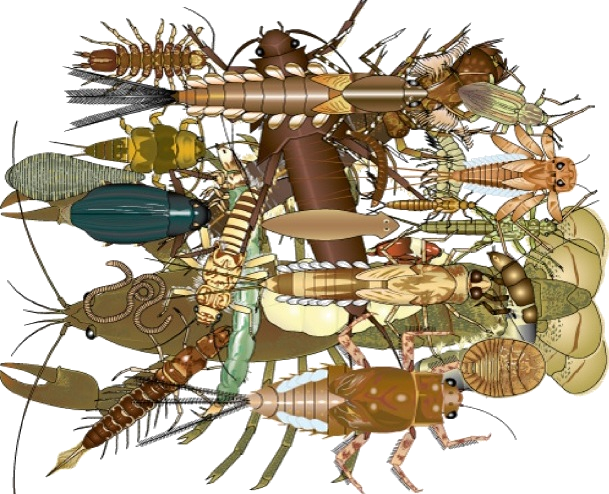 Various insect and non-insect benthic macroinvertebrates
Various insect and non-insect benthic macroinvertebrates
Overview
Benthic macroinvertebrates (BMIs) are critical components of stream ecosystems. WVDEP and others collect BMIs to evaluate the streams integrity and determine its capacity to
support aquatic life. This resource is designed to provide a better understanding of the wide vareity of aquatic invertebrates found in our rivers, streams and wetlands.
In addition to images, general information is included about the distinguishing features of the aquatic stage that aid in identification, and a scale for the organisms feeding group,
tolerance, size range and habitat. Larval and adult images are also provided for many families.
Contact Us
Watershed Improvement Branch
West Virginia Department of Environmental Protection
601 57th Street SE
Charleston, WV 25304
Phone: (304) 926-0440
Email: Contact Us
Guide to West Virginia Aquatic Invertebrates
Aquatic invertebrates are excellent indicators of watershed health because they: live in the water for all or most of their life, stay in areas suitable for their survival, are easy to collect, differ in their tolerance to amount and types of pollution, are easy to identify in a laboratory and in the field, often live for more than one year, and are important components of a stream's nutrient and energy system.
Plants and animals are classified according to the hierarchial system that arranges the organisms into groups based upon their similarities. These groups are arranged from general to very specific. The science of classification is known as taxonomy.
Explore Aquatic Invertebrates of WV
Expand each of the insect and non-insect sections below to explore the benthic macroinvertebrate (BMI) groups found in West Virginia streams.
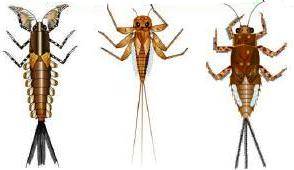 Ephemeroptera
Ephemeroptera
Mayflies
Order: Ephemeroptera
Wing pads may be present on the thorax; three pairs of segmented legs attach to the thorax; one claw occurs on the end of the segmented legs; gills occur on the abdominal segments and are attached mainly to the sides of the abdomen, but sometimes extend over the top and bottom of the abdomen; gills consist of either flat plates or filaments; three long thin caudal (tails filaments) usually occur at the end of the abdomen, but there may only be two in some kinds.
Swimming Mayflies
-
Ameletidae (Ameletid Minnow Mayfly)
Comb of stiff spines on the mouthparts; gills have a dark, sclerotized (hard) band along the outside edge; antennae are shorter than twice the width of the head; usually have dark bands on the tail and alternating dark and light on the abdomen. Swimmer/clinger; Collector/gatherer; VS-M (L)(F).
Ameletidae Adult Form
-
Baetidae (Small Minnow Mayfly)
Antennae two times longer than the width of the head; gills variable in shape and attached at abdominal segments one through seven; two or three caudal (tail) filaments. Swimmer; Collector/gatherer; VS-M (M)(F/S).
Baetidae Adult Form
-
Isonychiidae (Brush-Legged Mayfly)
Forelegs have a double row of hairs; gills oval shaped and present on abdominal segments one through seven; long hairs on the margins of the caudal filaments. Swimmer/crawler; Collector/gatherer; S-M (L)(F).
Isonychiidae Adult Form
-
Siphlonuridae (Primitive Minnow Mayfly)
Antennae less than two-time the width of the head; gills usually oval shaped and present on abdominal segments one through seven; long setae on the caudal filaments. Swimmer; Collector/gatherer; S-M (L)(F/S).
Siphlonuridae Adult Form
Clinging/Crawling Mayflies
Burrowing Mayflies
-
Beatiscidae (Armored Mayfly)
Top portion of the thorax is fused and coves most of the abdomen concealing the gills; caudal filaments are short and fringed with hairs. Burrower/crawler; Collector/gatherer; VS-M (M)(F).
Beatiscidae Adult Form
-
Ephemeridae (Burrowing Mayfly)
Has upturned mandibular tusks; head and front legs slightly widened and are used for burrowing; gills on the upper abdominal segments are small and the remaining gills are forked with fringed margins (feathered) and held over the top and sides of the abdomen. Burrower; Collector/gatherer; M-L (M)(S/F).
Ephemeridae Adult Form
-
Potamanthidae (Hackle-Gilled Mayfly)
Mandibular tusks present; front legs slender, not modified for burrowing; gills on segment one small, gills on remaining abdominal segments are feathery. Burrower; Collector/gatherer; S-M (M)(S/F).
Potamanthidae Adult Form
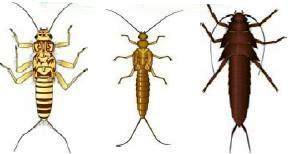 Plecoptera
Plecoptera
Stoneflies
Order: Plecoptera
Long thin antenna project in front of the head; wing pads usually present on the thorax but may only be visible in older larvae; three pairs of segmented legs attach to the thorax; two claws are located at the end of the segmented legs; gills occur on the thorax region, usually on the legs or bottom of the thorax, or there may be no visible gills (usually there are none or very few gills on the abdomen); gills are either single or branched filaments; two long thin tails project from the rear of the abdomen. All stoneflies have low-very low (L) tolerance to many insults; however, several families are tolerant of slightly acidic conditions.
Patterned Stoneflies
-
Chloroperlidae (Green Stonefly)
Body elongated, front of the thorax slightly wider than the abdomen; wing pads not divergent from the midline; tails shorter than the abdomen. Will sometimes have patterns similar to Perlodidae. Clinger/crawler; Shredder/predator; M (F).
Chloroperlidae Adult Form
-
Perlidae (Common Stonefly)
Usually a large strikingly patterned and often having a golden color; finely branched gills present on all thoracic segments; wing pads diverge slightly from the midline. Clinger/crawler; Predator; M-L (F).
Perlidae Adult Form
-
Perlodidae (Perlodid Stonefly)
Strikingly patterned and colored similar in appearance to Perlidae; hind wing pads divergent; no gills on the thoracic segments. Clinger/crawler; Shredder; M-L (F).
Perlodidae Adult Form
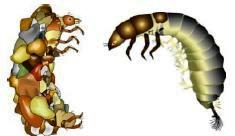 Trichoptera
Trichoptera
Caddisflies
Order: Trichoptera
Head has a thick hardened skin; antennae are very short, usually not visible; no wing pads occur on the thorax; top of the first thorax always has a hardened plate and in several families the second and third section of the thorax have a hardened plate; three pairs of segmented legs attach to the thorax; abdomen has a thin soft skin; single or branched gills on the abdomen in many families, but some have no visible gills; pair of prolegs with one claw on each, is situated at the end of the abdomen; most families construct various kinds of retreats consisting of a wide variety of materials collected from the streambed.
Net-Spinning Caddisflies
-
Hydropschiidae (Common netspinner)
Top of all thoracic segments hardened; most abdominal segments have tufts of finely branched gills; anal prolegs terminate into a brush of hairs. Does not make cases but instead creates a retreat (net) made of a variety of materials held together by fine strands of silk. Note: Can be green in color and look similar to free-living caddisflies. Clinger/crawler; Collector/filterer; M-L (M)(F/S).
Hydropschiidae Adult Form
-
Philopotamidae (Finger-net caddisfly)
Labrum is t-shaped and membranous; head capsule large usually bright yellow or cream colored; only first thoracic segment is hardened; abdominal gills usually absent. Builds a long tube or finger-like net. Clinger/crawler; Collector/filterer; M (L)(F).
Philopotamidae Adult Form
-
Polycentropodidae (Tube-net caddisfly)
Labrum is rounded and hardened; only first thoracic segment is hardened; no plates or gills on the abdominal segments. Does not build cases but instead constructs a net that is often in the shape of a long tube. Clinger/crawler; Collector/filterer/predator; S-L (M)(F/S).
Polycentropodidae Adult Form
-
Psychomyiidae (Trumpet-net caddisfly)
Bottom of thorax is hardened with black edges; middle thoracic segment is swollen and usually larger than the others; has an enlarged hatchet shaped leg segment on the upper legs. Thier nets are variable but most have a tube-shape. Clinger/crawler; Collector; M (M)(F).
Psychomyiidae Adult Form
Free-Living Caddisfly
-
Rhyacophilidae (Free-living caddisfly)
First thoracic segment is hardened; abdominal gills variable; hardened plate on top of abdominal segment nine; distinctive anal prolegs with large claws. This family does not build a case or net, but often uses silk strands to attach itself to substrates. Clinger/crawler; Predator; M-L (L)(F).
Rhyacophilidae Adult Form
Additional Information
Case-Building Caddisflies
-
Brachycentridae (Humpless-case caddisfly)
Antennae close to the margins of the head capsule; first two thoracic segments with hardened plates; no humps on abdominal segments; gills simple or lacking. The case is elongated and made of strips of materials, resembles a log cabin. Clinger; Collector/gatherer/shredder; M (L)(F).
Brachycentridae Adult Form
-
Glossosomatidae (Saddle-case caddisfly)
First thoracic segment is hardened; hardened plate on top of abdominal segments nine. The case resembles a tortoise shell or saddle. Clinger; Scraper/shredder; VS-M (L)(F).
Glossosomatidae Adult Form
-
Goeridae (Goerid-case caddisfly)
Hardened head, yellow to reddish brown colored; large horn-like structure on the thorax. The case is constructed with sand-grains and small pebbles, usually is slightly curved. Clinger; Scraper; VS-M (L)(F/S).
Goeridae Adult Form
-
Helicopsychidae (Snail-case caddisfly)
Body is curled; all three thoracic segments are hardened; stout hairs at the end of the third thoracic segment; gills present on anterior abdominal segments. The case resembles a snail shell. Clinger; Scraper; VS-S (L)(F).
Helicopsychidae Adult Form
-
Hydroptilidae (Purse-case caddisfly)
All three of their thoracic segments have sclerotized dorsal plates; no gills on the abdomen; most commonly build cases with sand, algae, silk or detritus, but the shapes vary considerably. Clinger/crawler; Scraper; VS-S (M)(F/S).
Hydroptilidae Adult Form
-
Lepidostomatidae (Scaly-mouth caddisfly)
Antennae located close to the eyes; lateral hump on abdominal segment one; first two thoracic segments hardened; gills simple or lacking; hardened plate on top of abdominal segment nine. The case is usually four-sided built with square pieces of barks and leaves. Clinger/crawler; Shredder; S-M (L)(F).
Lepidostomatidae Adult Form
-
Leptoceridae (Longhorn-case caddisfly)
Antennae prominent; first two thoracic segments hardened; hind legs are usually longer than the front legs; abdominal gills variable. The cases are built from a variety of materials and vary considerably; the most common is a stone/sand case resembling a long tube. Clinger/crawler; Collector/predator; S-M (L)(F/S).
Leptoceridae Adult Form
-
Limnephilidae (Northern-case caddisfly)
Antennae between the eyes and the mouth; first two thoracic segments hardened; dorsal and lateral humps on first abdominal segment; hardened plate on the top of abdominal segment nine; abdominal gills variable. The cases are built from many kinds of bottom materials and exhibit a wide variety of shapes and sizes. Clinger/crawler; Shredder; S-L (L)(F).
Limnephilidae Adult Form
-
Molannidae (Hooded-case caddisfly)
Two-thirds of the top of the thorax is hardened; tarsal claws on the hind legs smaller than the rest and are covered with fine hairs; gills along the abdomen are simple or branched; a hardened plate sits atop abdominal segment nine. The cases are constructed mostly with sand and pea gravel, shaped like a flattened tube with a hood that extends over the opening. Clinger/crawler; Collector/shredder; S-M (M)(S).
Molannidae Adult Form
-
Phryganeidae (Giant-case caddisfly)
Head and portions of the thorax marked with prominent stripes; front part of the thorax hardened; dorsal and lateral humps on abdominal segment one; hardened plate on top of abdominal segment nine. They build elongated cases out of plant fragments. Certain genus are known to feed on amphibian egg-sacks. Clinger/crawler; Collector/predator; M-L (M)(S).
Phryganeidae Adult Form
-
Uenoidae (Uenoid-case caddisfly)
The first two thoracic segments are hardened and there are some small plates present on the third; abdominal segment one has a hump, and the anterior margin of their mesonotum is notched on either side of the midline; cases are variable but usually always constructed with small stones and sand. Clinger/crawler; Scraper; S-M (L)(F).
Uenoidae Adult Form
 Lepidoptera
Lepidoptera
Aquatic Moth
Order: Lepidoptera
Head hardened; a few families have elongated lateral gills; three pairs of segmented legs attach to the thorax; abdomen with prolegs that end in tiny hooks. They often look very similar to terrestrial caterpillars; closely related to Trichoptera. Crawler/burrower; Shredder; VS-M (M)(S/F).
Lepidoptera Adult Form
 Odonata
Odonata
Dragonflies and Damselflies
Order: Odonata
Dragonflies: Lower lip (labium) is long and elbowed to fold back against the head when not feeding, thus concealing other mouthparts; wing pads are present on the thorax; three pairs of segmented legs attach to the thorax; no gills on the sides of the abdomen; three pointed structures may occur at the end of the abdomen forming a pyramid shaped opening; bodies are long and stout or some- what oval. Damselflies: Three flat gills at the end of the abdomen forming a tail-like structure and their bodies are long and slender.
Dragonflies (Sub-Order Anisoptera)
Damselflies (Sub-Order Zygoptera)
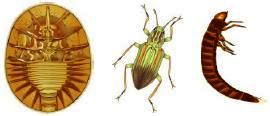 Coleoptera
Coleoptera
Beetles
Order: Coleoptera
Head has thick hardened skin; thorax and abdomen of most adult families have moderately hardened skin, several larvae have a soft-skinned abdomen; no wing pads on the thorax in most larvae, but wing pads are usually visible on adults; three pairs of segmented legs attach to the thorax; no structures or projections extent from the sides of the abdomen in most adult families, but some larval stages have flat plates or filaments; no prolegs or long tapering filaments at the end of the abdomen. Beetles are one of the most diverse the insect groups, but are not as common in aquatic environments. Most of the adult stages of the families listed here are aquatic or semi-aquatic.
-
Crysomelidae (Reed Beetle)
The body is soft; three-pairs of segmented legs attached to the thorax and two hooks on the lower end of the abdomen. Crawler; Collector/gatherer; S-M (H)(S).
-
Dytiscidae (Predacious Diving Beetle)
Legs have five-segments and two-claws on the end; abdomen terminates into a pair of filaments. Adult: slender antennae; hind coxae extends posterior dividing the first abdominal segment into two sections. Swimmer/crawler; Predator; VS-VL (M)(S).
Dytiscidae Adult Form
-
Elmidae (Riffle Beetle)
Larvae: Legs with four segments and a single claw; nine abdominal segments some with a cavity that protect the hind gills. Adult: hard bodied, slender sometimes clubbed antennae; the forewings have numerous rows of indentations; legs long compared to body. Clinger/crawler; Scraper/shredder; VS-S (M)(F).
-
Gyrinidae (Whirligig Beetle)
Two claws of each leg, legs with five segments; ten abdominal segments with pairs of lateral filaments. Adult: compound eyes, which appear divided into pairs; antennae clubbed; mid and hind legs paddle-like. Swimmer/crawler; Predator; S-L (M)(S/F).
Gyrinidae Adult Form
-
Haliplidae (Crawling Water Beetle)
Legs with five segments and a single claw; abdomen terminates into long filaments; some have many long slender filaments along the entire length of the body. Adult: antennae long and slender; forewings have many indentations; legs lined with small hairs for swimming. Swimmer/crawler; Shredder; S-M (H)(S).
Haliplidae Adult Form
-
Hydrophlidae (Water Scavenger Beetle)
Large mandibles; legs with four segments and a single claw; end of the abdomen usually blunt. Adult: antennae clubbed with cup-like segments at the base; hind coxae (joined base) do not extend or divide the abdomen. Swimmer/crawler; Predator; VS-VL (H)(S).
Hydrophlidae Adult Form
-
Psephenidae (Water Penny)
Body flattened with thoracic and abdominal segments expanded so that the legs and head are obscured from above; legs terminate into a single claw. The adult is semi-aquatic, sometimes encountered near the stream. Clinger/crawler; Scraper; VS-M (L)(F).
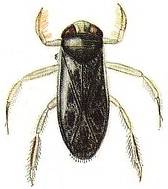 Hemiptera
Hemiptera
True Bugs
Order: Hemiptera
The most distinguishing characteristic of the order is the mouthparts that are modified into an elongated, sucking beak. Most adults have hemelytra, which are modified leathery forewings. Some adults and all larvae lack wings; both most mature larvae posses wing pads. Both adults and larvae have three-pairs of segmented legs with two tarsal claws at the end of each leg. Many families are able to also utilize atmospheric oxygen. This order is generally not used for the biological assessment of flowing waters, due to their ability to use atmospheric oxygen. Several families are described.
Surface
-
Corixidae (Water Boatman)
Broad triangular beak; forelegs are scoop-like and fringed with hairs; antennae are short and concealed beneath the eyes. Swimmer; Predator; VS-M (H)(S).
-
Gerridae (Water Striders)
Variable body shape; cylindrical beak; rear legs extend well beyond the tip of the abdomen. Swimmer; Predator; VS-M (H)(S).
-
Mesoveliidae (Water Treader)
Antennae longer than the head; long slender spiny legs with three segments. Swimmer/crawler; Predator; S-M (U)(S).
-
Notonectidae (Backswimmer)
Body cylindrical; antennae are short and concealed beneath the eyes; hind legs are oar-like; hind tarsal claws inconspicuous. Swimmer; Predator; M (H)(S).
Sub-Surface
-
Belostomatidae (Giant Water Bug)
Large oval body; antennae are short and concealed beneath the eyes; raptorial front legs. Swimmer/clinger; Predator; M-VL (H)(S).
-
Hydrometridae (Water Measurer)
Body slender and elongated; antennae longer than the head; head usually longer than the thorax; legs are long and slender, each with two claws. Clinger/crawler; Predator; S-M (H)(S).
-
Nepidae (Water Scorpion)
Body long and cylindrical; antennae are inconspicuous and concealed beneath the eyes; forelegs are raptorial other legs are long and slender; abdomen terminates into a long breathing appendage. Clinger/crawler; Predator; M-L (H)(S).
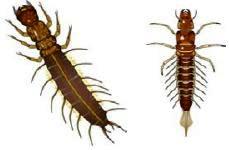 Megaloptera
Megaloptera
Hellgrammite, Fishfly, and Alderfly
Order: Megaloptera
Head and thorax has thick hardened skin, while the abdomen has thin soft skin; prominent chewing mouthparts project in front of the head; no wing pads on the thorax; three pairs of segmented legs attach to the thorax; seven or eight pairs of stout tapering filaments extend from the abdomen; end of the abdomen has either a pair of prolegs with two claws on each proleg, or a single long tapering filament with no prolegs.
-
Corydalidae (Hellgrammite)
Elongate dorsally flattened body; large jaws on the head, projecting forward; first eight abdominal segments and segment ten with paired lateral filaments; gill-tufts beneath/beside the filaments; abdomen terminates in fleshy appendages bearing hooks. Clinger/crawler; Predator; M-VL (L)(F).
Corydalidae Adult Form
-
Chauliodinae (Fishfly):
Elongate dorsally flattened body; large jaws on the head, projecting forward; first eight abdominal segments and segment ten with paired lateral filaments; no gill-tufts; abdomen terminates in fleshy appendages bearing hooks. Clinger/crawler; Predator; M-L (L)(F).
Chauliodinae Adult Form
-
Sialidae (Alderfly)
Elongate dorsally flattened body; large jaws on the head, projecting forward; first seven abdominal segments and segment ten with paired lateral filaments; abdomen terminates into a single long hairy filament. Crawler/burrower; Predator; S-L (M)(S/F).
Sialidae Adult Form
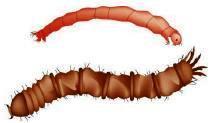 Diptera
Diptera
True Flies
Order: Diptera
Head may be a capsule-like structure with thick hard skin; head may be partially reduced so that it appears to be part of the thorax, or it may be greatly reduced with only the mouthparts visible; no wing pads occur on the thorax; false-legs (pseudo-legs) may extend from various sections of the thorax and abdomen in some families; no segmented legs in the larval forms; thorax and abdomen composed of entirely soft skin, but some families have hardened plates scattered on various body features. Note: the larval stages do not have legs.
Flies
-
Athericidae (Watersnipe Fly)
Body long (caterpillar-like); head reduced but may be visible; prolegs on most abdominal segments; abdomen ends in a fringed tail. The family is often green in color. Clinger/crawler; Predator; S-M (L)(F).
Athericidae Adult Form
-
Empididae (Dance Fly)
Body elongated; head reduced or pulled into the thorax; prolegs present on most abdominal segments; prolegs longer on segment eight; abdomen is blunt on the end or terminates in welts. Crawler/burrower; Predator; VS-M (H)(S/F).
Empididae Adult Form
-
Muscidae (Muscid Fly)
Anterior portion of the body tapered, posterior is blunt; head reduced orwithdrawn into thorax; whelps on abdominal segments; abdomen terminates into a pair of respiratory tubes. Burrower; Predator; S-M (H)(S/F).
Muscidae Adult Form
-
Psychodicae (Moth Fly)
Head hardened, rounded and separate from the thorax; body segments with two to three secondary divisions (annuli) often having hardened plates. Burrower; Collector/gatherer; VS-S (H)(S).
-
Ptychopteridae (Phantom Cranefly)
Head hardened and rounded; prolegs present on abdominal segments one through three, terminating with claws; abdomen terminates into a long respiratory tube. Crawler/burrower; Collector/gatherer; M (H)(S).
Ptychopteridae Adult Form
-
Simuliidae (Black Fly)
Head hardened and rounded bearing a pair of labral fans (mouth brushes); prolegs on lower thorax; lower third of the abdomen is swollen (vase-like) and terminates in a ring of hooks. Clinger; Collector/filterer; VS-M (M)(F).
Simuliidae Adult Form
-
Stratiomyidae (Soldier Fly)
Body is flattened dorsally with a leathery feel; head is reduced but visible; thorax is broader than the head; spiracles at the end of the abdomen for breathing. Swimmer/burrower; Collector/gatherer; S-L (H)(S).
Stratiomyidae Adult Form
-
Tabanidae (Horse Fly)
Body spindle shape both ends tapered; head reduced usually not visible; creeping welts with small hooks present on abdominal segments one through seven; no prolegs. Crawler/burrower; Predator; M-VL (H)(S/F).
Tabanidae Adult Form
-
Tipulidae (Crane Fly)
Rounded head capsule, often reduced and barely visible; ventral welts on some abdominal segments; abdomen terminates into a disc surrounded by lobes or tentacle-like projections of varying shapes. Crawler/burrower; Shredder/predator; VS-VL (M)(F/S).
Tipulidae Adult Form
 Collembola
Collembola
Springtails
Order: Collembola
Abdomen consisting of six segments, the first having collophores; abdomen terminates into a forked appendage. Has a habit of jumping on the surface of the water. Swimmer/crawler; Collector/gatherer; VS (M)(S).
 Neuroptera
Neuroptera
Spongilliflies
Order: Neuroptera
Antennae long and multi-segmented; jaws long and needle-like; body covered in tiny hairs (seta); has a pair of hardened plates on the thorax and each abdominal segment. They are associated with freshwater sponges, found on the outside or in the canals of the sponge. Clinger; Piercer; VS-S (U)(S).
 Arachnida
Arachnida
Water Mites
Class: Arachnida
Family: Hydrachnidae
Four-pairs of segmented legs; one-pair of pedipalps; body is rounded and appears to consist entirely of an abdomen without segments. When captured will move rapidly in a circular pattern. Swimmer/crawler; Predator; S-M (M)(F).
Learn More
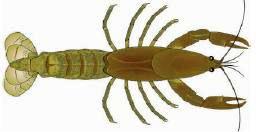 Crustacea
Crustacea
Crayfish, Shrimp, Scuds and Sowbugs
Sub-Phylum: Crustacea
More than three pairs of legs (> 6) attached to the thorax; the first several pairs of legs may have a hinged claw, which is often enlarged as in the order Decapoda; bodies strongly flattened from top to bottom or from side to side; abdomen consists of individual segments or the segments may be fused to form a thoracic shield; some kinds have a broad flipper on the end of the abdomen.
Order Amphipoda
Order Isopoda
-
Asellidae (Aquatic Sowbug)
Body dorsally flattened; two-pairs of antennae one longer than the other; seven-pairs of legs, the first is claw-like and slightly enlarged, and the others have a simple pointed claw. Looks similar in appearance to its terrestrial cousin. Crawler/burrower; Collector/gatherer; S-M (H)(S/F).
Order Decapoda
-
Cambaridae (Crayfish)
Body mostly dorsally flattened; two-pairs of antennae one longer than the other; five-pairs of legs, first three-pairs with hinged claws and the first pair of claws are greatly enlarged; abdomen terminates in a flipper-like structure. Crawler/burrower; Collector/gatherer; M-VL (M)(S/F).
-
Palaemonidae (Freshwater Shrimp)
Cephalothorax and abdomen cylindrical with some side-to-side flattening; 5-pairs of walking legs the first two have claws, which are not enlarged; abdomen terminates in a flipper-like structure. Crawler/swimmer; Scraper; M-VL (M)(S).
Other
Crustaceans listed below are occasionally collected, but due to their very small sizes and unknown tolerances are not usually included in the biosurvey analysis.
-
Cladocera (Water Fleas)
Body is usually round or oval shaped appearing to consists of two valves as in a clam; large eyes on the head. Collector/Filterer (< 3 mm).
-
Copepoda (Copepods)
Body is cylindrical having a single eye; abdomen and some thoracic segments form a tail-like structure. Collector/Gatherer/Filterer (< 4 mm).
-
Ostracoda (Seed Shrimp)
Body is covered by a shell giving the organism a bivalve-like appearance. Most of the animal is covered but some of its appendages may protrude. Collector/Gatherer/Filterer ( < 3 mm).
 Annelida
Annelida
Leeches and Worms
Phylum: Annelida
Body is soft, muscular and cylindrical in shape; body consists of many similar, round ring-like segments arranged in rows; numerous segments along the entire length, number often depends upon the order or family. Leeches have distinct suckers situated on the bottom of the body, one at the front and one at the rear. All invertebrates within this category have a high tolerance to insults.
Worms
-
Oligochaeta (Aquatic Worm)
Body elongated (worm-like); divided into many segments most having bundles of small hairs; no
eyespots or suckers present. Aquatic earthworms are common in riffles; however wetlands have a much
wider variety from this group (i.e. Naidid worms, Tubiflex worms etc.) Crawler/burrower;
Collector/gatherer; VS-VL (F/S).
-
Nematoda (Round Worm)
Worm-like; no segmentation; body usually translucent or having a pale coloration. Crawler/burrower;
Collector/gatherer; VS-M (S).
-
Nematomorpha (Horsehair Worm)
Body very long and slender; no segments. Burrower; Parasite/predator; VL (S).
 Turbellaria
Turbellaria
Flatworms
Phylum: Platyhelminthes
Class: Turbellaria
Soft-elongated body flattened from top to bottom; no individual segments; digestive track with only one opening which functions both as the mouth and anus; mouth usually on the bottom side positioned about one-fifth to the length of the body; sides of the body constricted towards the front forming a head that is often somewhat triangular shaped; two eyespots situated on top of the head gives the animal a cross-eyed appearance. Most families can withstand high nutrient and organic enrichment, but some are very sensitive to toxics. Crawler/burrow; collector/gatherer; VS-L (H)(S/F).
Additional Information
-
Phylum Platyhelminthes
The simplest animals that are bilaterally symmetrical and triploblastic (composed of three fundamental cell layers) are the Platyhelminthes, the flatworms.
-
Class Turbellaria
Flatworm feeding, habitat, movement, size, life cycle and other characteristics.
 Gastropoda
Gastropoda
Snails
Class: Gastropoda
Operculate snails: Flat lid-like structure called an operculum that can seal the body of the snail inside the shell; the whorls of the shell bulge out distinctively to the sides (inflated); most have their opening on the right when the narrow end is held up; shells often extended into a spiral shape.
Non-operculate snails: No operculum; the whorls of the shell do not distinctly bulge out to the sides; often the shells of most kinds are shaped like a low flat cone or coiled flat instead of being extended in a spiral shape. Typical size range for most snails is VS-L, which includes the shell.
Operculate Snails (Sub-Class Prosobranchia)
-
Hydrobiidae (Pebble Snail)
Shell is whorled and bulges out to the side (inflated); opens to the right when the narrow end is held up. The family is very diverse in shell size and shape; shell shape can range from conical (cone-like) to spherical (rounded). Clinger/crawler; Scraper; (L)(F).
-
Pleuroceridae (Rock Snail)
Shell is spiraled and whorled but does not budge out to the side (flattened); opens to the right when the narrow end is held up; operculum is small and can be pulled into the shell. Clinger/crawler; Scraper; (L)(F).
-
Valvatidae (Valve Snail)
Shell is small, flattened and conical shaped: operculum is multi-spiraled. Clinger/crawler; Scraper (L)(S).
-
Viviparidae (River Snail)
Shell is whorled and bulges out to the side (inflated); opens to the right when the narrow end is held up; operculum has concentric lines, which are slightly off-center. Clinger/crawler; Scraper; (M)(S).
Non-Operculate Snails (Sub-Class Pulmonata)
-
Ancylidae (Limpet)
Shell shaped like a low flat cone. Clinger/burrower; Scraper
-
Lymnaeidae (Pond Snail)
Shell vaiable from long needle-like spirals to flat cones. Most often found in waters with high mineral content. Clinger/crawler; Scraper; (H)(S/F).
-
Planorbidae (Orb Snail)
Shell is coiled flat instead of extended in a spiral. Clinger/burrower; Scraper; (M)(S/F).
-
Physidae (Pouch Snail)
Shell is high, spiraled, with a slight bulge; opens to the left when the narrow end is held up. Clinger/crawler; Scraper; (H)(S/F).
Additional Information
Note: North American streams, rivers, and lakes support the richest diversity of freshwater mollusks on the planet. Over 650 species of snails and 300 species of freshwater mussels have been described so far.
 Bivalvia
Bivalvia
Clams and Mussels
Order: Bivalvia
Two shells opposite of each other and strongly connected by a hinged ligament; the shell is thick and strong or thing and fragile in some kinds; growth rings on the shell are either far apart and are distinctly raised, or very close together and hardly raised at all; the foot usually consists of two tubular structures that can often be seen protruding from the shell; the body is soft tissue, often pinkish or gray in color.
Clams
-
Corbiculidae (Asian Clam)
Shell is rounded; brown in color usually lighter than mussels; raised separated ridges along the top and sides of the shell. Clinger/burrower; Collector/filterer; VS-VL (M)(S/F).
-
Sphaeriidae (Pea Clam)
Shell is very small and rounded; light colored; ridges spaced close together, not raised. Clinger/burrower; Collector/filterer; VS-M (M)(S/F).
Mussels
-
Unionidae (Mussel)
Largest of the bivalves; shell usually dark in color, variable in shape but maybe somewhat oblong; has many indentations and ridges on the tops and sides of the shell. Clinger/burrower; Collector/filterer; VS-VL (L)(S/F).
-
Dreissenidae (Zebra Mussel)
Gets their common name from the striped pattern of their shells, though not all shells bear this pattern; usually about fingernail size but can grow to a maximum length of nearly two inches; often they can be found in large colonies attached to a variety of objects. Clinger; Collector/filterer; VS-M (M)(S).
 Hydrozoa
Hydrozoa
Freshwater Jellyfish
Class: Hydrozoa
Usually small and bell-shaped; tentacles of varying lengths protrude from the margins of the velum; is often translucent with a whitish or greenish tinge. Swimmer/clinger; Collector/predator; VS-S (U)(S).
Photos
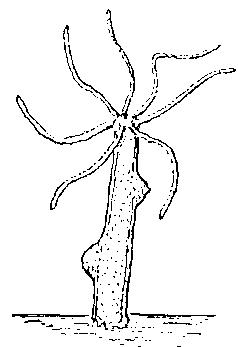 Spongilla
Spongilla
Freshwater Sponge
Class: Spongilla
Sponges are delicate in structure, growing as encrusting or branching masses; usually appear greenish because of the algae that live on them. Freshwater sponges may attain a volume of more than 2,500 cubic centimeters (150 cubic inches). Spongilliflies can sometimes be found in the canals or the outside of sponges. Filterers; S-VL (U)(S/F).
Additional Information
-
Back Creek Freshwater Sponges
Sponges are multicellular animals consisting of masses of cells embedded in a gelatinous matrix. The matrix is bound together by minute, spine-like structures of calcium or silica called spicules and spongy organice fibers called spongin.
-
Spongillaflies
Sisyridae, commonly known as spongeflies or spongillaflies, are a family of winged insects in the order Neuroptera. There are approximately 60 living species described, and several extinct species identified from the fossil record.
Benthic Resources
Overview
Provided here are a wide variety of resources that will help you become more familiar with benthic
macroinvertebrates. There are examples of simple field guides, family-level manuals and a wide variety of
additional resources. You may begin your study by choosing one of the links from the list of resource below.
Many of the links below are or include portable document files (PDF).
Benthic ID Guides and More
Additional Benthic Information